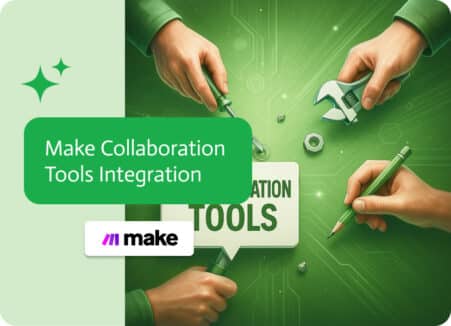

Top 8 SnapLogic Alternatives
As businesses seek more efficient and user-friendly integration solutions, many are looking beyond SnapLogic to platforms that offer enhanced accessibility, scalability, and AI-driven capabilities. If you’re in search of a robust alternative, here’s a look at the top 8 SnapLogic alternatives, each addressing specific challenges that SnapLogic users often encounter.
1. Noca AI: The Best SnapLogic Alternative
Noca AI stands out as the premier alternative to SnapLogic, offering a host of advanced features that directly address SnapLogic’s limitations:
- AI-Powered Accessibility: Noca AI’s intuitive interface, powered by artificial intelligence and natural language processing, significantly reduces the learning curve, making it accessible to users of all technical levels.
- Scalable Pricing: With flexible pricing options, Noca AI is suitable for businesses of all sizes, from startups to large enterprises, allowing companies to scale their integration capabilities as they grow.
- Simplified Complexity: The platform’s AI-driven suggestions and implementations simplify even the most complex integration scenarios, making it easier for businesses to manage their integrations efficiently.
- Automated Performance Optimization: Machine learning algorithms continuously optimize integration performance, reducing the need for manual intervention and ensuring that integrations run smoothly at all times.
- True No-Code Experience: Noca AI enables business users to create sophisticated integrations using natural language, eliminating the need for coding skills and empowering non-technical users to manage complex tasks.
2. Zapier: User-Friendly Automation for Small to Medium Businesses
Strengths: Zapier is known for its ease of use and extensive app integrations, making it an excellent choice for businesses that need to automate simpler workflows without diving deep into complex coding.
Limitations: However, Zapier may lack the advanced features required for more complex enterprise needs, making it less suitable for large-scale operations.
3. Workato: Intelligent Automation Platform
Strengths: Workato offers AI-powered suggestions and robust enterprise features, with a strong emphasis on security and compliance, making it ideal for larger businesses.
Limitations: Despite its powerful capabilities, Workato can be overly complex for very simple integrations, which might deter smaller businesses from fully leveraging its potential.
4. MuleSoft: Comprehensive API-led Connectivity
Strengths: MuleSoft excels in API management and connectivity, making it a go-to platform for large enterprises needing comprehensive integration solutions.
Limitations: The platform’s steep learning curve and higher cost can be prohibitive for smaller organizations, limiting its appeal to enterprises with substantial integration needs and resources.
5. Boomi: Cloud-Native Integration Platform
Strengths: Boomi offers a wide range of connectors and strong data mapping capabilities, making it a versatile option for cloud-native integration projects.
Limitations: However, Boomi’s user interface can be challenging for beginners, which might slow down the learning process and implementation speed.
6. Make (formerly Integromat): Visual Automation Platform
Strengths: Make is known for its intuitive visual editor, allowing users to automate complex processes without coding. It offers a wide range of templates and integrations, making it easy to get started and customize workflows.
Limitations: The platform can have a steep learning curve for beginners, and managing complex workflows might require extra effort. Pricing can escalate with increased usage, which could be a factor for growing businesses.
7. Celigo: iPaaS for NetSuite and Beyond
Strengths: Celigo offers strong integration capabilities for NetSuite, along with pre-built integrations for other popular apps, making it an excellent choice for businesses already using NetSuite.
Limitations: The platform’s primary focus on NetSuite may not suit businesses that require a broader range of integrations beyond this ecosystem.
8. Jitterbit: API Integration Platform
Strengths: Jitterbit provides robust API creation and management, making it well-suited for businesses that need both on-premises and cloud integrations.
Limitations: It can require technical expertise to handle complex integrations, which might be a barrier for organizations without in-house technical resources.
Why Noca AI Stands Out Among SnapLogic Alternatives
While each of these alternatives offers unique strengths, Noca AI emerges as the standout choice for organizations seeking to overcome the challenges associated with SnapLogic. By leveraging cutting-edge AI technology, Noca AI provides a more accessible, scalable, and efficient integration solution that caters to businesses of all sizes and technical capabilities.
- Learning Curve: Noca AI’s intuitive, AI-powered interface significantly reduces the time and training required to become proficient, making it easier for teams to get up and running quickly.
- Cost: With a flexible pricing model, Noca AI offers a more cost-effective solution for businesses at various stages of growth, ensuring that even smaller companies can afford powerful integration tools.
- Complexity: The AI-driven platform simplifies even the most complex integrations, making it accessible to users with varying levels of technical expertise and reducing the burden on IT teams.
- Performance Tuning: Automated optimization through machine learning eliminates the need for manual fine-tuning and specialized knowledge, ensuring that integrations perform optimally without constant oversight.
- Low-Code Limitations: Noca AI’s true no-code approach enables even non-technical users to create sophisticated integrations without writing code, democratizing the integration process across the organization.
Conclusion
SnapLogic remains a powerful tool for certain enterprise scenarios, but the alternatives listed above, particularly Noca AI, offer compelling solutions that address its limitations. As businesses continue to prioritize accessibility, scalability, and efficiency in their integration strategies, platforms like Noca AI are poised to lead the way in the evolving landscape of enterprise integration. Whether you’re a small startup or a large enterprise, exploring these alternatives can help you find the integration solution that best meets your needs.

